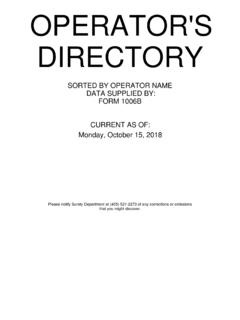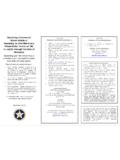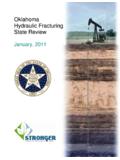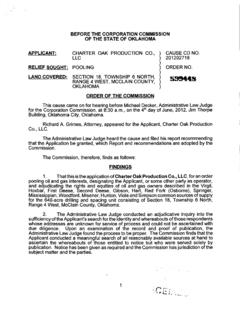Transcription of Basic Information for the Oklahoma Royalty Owner
1 Basic Information for the Oklahoma Royalty Owner Last Revision - September 2012. Prepared by: Oil & Gas Complaints & Information Department Consumer Services Division Oklahoma Corporation Commission Basic Information for the Oklahoma Royalty Owner This Information was prepared by the Oil & Gas Complaints & Information Department in the Consumer Services Division of the Oklahoma Corporation Commission. The Information is general in nature and does not specifically relate to any particular case or hearing conducted at the Commission. Any subsequent rule change or legislative change after the effective date of this booklet, September 2012, could alter the Information included.
2 We suggest that you consult your own attorney for specific answers if you have a particular legal question or any pending litigation rather than relying on the general Information included in this booklet. This publication is issued by the Consumer Services Division of the Oklahoma Corporation Commission as authorized by the Director of Administration. One- hundred copies have been prepared and distributed at a cost of $ Copies have been deposited with the Publications Clearinghouse of the Oklahoma Department of Libraries. Table of Contents Basic Information 3. Frequently Asked Questions about Horizontal Drilling 13. Helpful Telephone Numbers 20.
3 Calculation of Royalties under SB 168 21. OCC County Codes 22. County Contacts 23. Section Plat with Footages 31. United States Land Survey 32. System OCC Database Instructions New Well Browse 34. Operator Browse 35. Imaged Records Access 36. Case Processing 37. 2. Basic Information Hearings at the Corporation Commission: The State Office of the Corporation Commission is located in Oklahoma City and is the Western Regional Service Office for the Commission. The Commission Eastern Regional Service Office is located in Tulsa. Court Rooms at the Oklahoma Corporation Commission are located on the first and third floors of the Jim Thorpe Building, southwest of the Capitol at 2101 North Lincoln Boulevard in Oklahoma City, Oklahoma .
4 The Court Rooms at the Corporation Commission in Tulsa are located on the first floor of the Kerr State Office Building, 440 South Houston. Hearings at the Corporation Commission are posted on the first floor of the Jim Thorpe Building on a bulletin board and on the OCC website at The weekly docket is posted on Wednesday for the following Monday through Friday. The daily docket is posted the day before the hearing. Usually there are over 100 hearings posted with courtroom assignments, so it is important that you know which one involves your land. The cases are posted according to the case number, applicant and county; therefore, it is important that you bring that notice with you in order to find your case and courtroom.
5 Courtroom Locations: Six courtrooms are located on the first floor of the Jim Thorpe Building and Courtroom 301, where Commission en banc hearings are conducted, is located on the third floor. There are two court rooms located on the first floor of the Kerr State Office Building in Tulsa. It is important that you arrive at the Commission well before 8:30 to find the courtroom to which your case has been assigned. Calling the Docket: An Administrative Law Judge (ALJ), at 8:30 , will call the cases for that day in the assigned courtroom. The ALJ will call the case number, the applicant, the type of case and the county. Each ALJ will have many cases assigned to hear that day.
6 When your case is called, announce your presence in the courtroom and let the ALJ know if you have an attorney or are representing yourself and if you are opposed to the application or not. Due to the large number of uncontested cases, protested cases usually must be scheduled on days that are specifically set aside to hear protested cases. Parties involved in a protested case must complete a pre-hearing conference agreement setting forth 3. issues and establishing the trial date. If the parties cannot agree upon a date, the ALJ will select a date. Notice for Emergency Hearings: OAC 165:5-9-3, which was recently amended, states that notice of hearing on an emergency application shall be served on all parties otherwise entitled to notice under the base application not less than five (5) business days prior to the emergency hearing.
7 A business day is a day that is not a Saturday, Sunday, or a legal holiday. Other types of notice are also counted in business days. Spacing Defined: A drilling and spacing order issued by the Corporation Commission establishes a geographical area in which only one oil and/ or gas well can be initially drilled and produced from the geological formation listed in the order. The spacing unit communitizes all Royalty interest owners for the purpose of sharing in production from oil and/or gas wells in the unit. A spacing order establishes the size of the unit; names the formations included in the unit; divides the ownership of the unit for the formations into the Royalty interest (1/8) and the working interest (7/8); puts all the owners of Royalty interests into one community.
8 Establishes that each unleased working interest Owner has the right to drill within the unit; and establishes an area within the unit where the well may be drilled. Unit Well(s): Only one well can be drilled and completed in each common source of supply. The spacing order will also specify the permitted location where the unit well may be drilled. Under certain circumstances, additional wells may be drilled, but only after an application is filed, a hearing conducted, and an Increased Density Order is issued by the Commission. Drilling and Spacing Units: Below is a list of the standard sizes for drilling and spacing units and the permitted well locations within the unit.
9 The well can be located no closer to the unit boundaries than this: Square Units: Rectangular Units: 640 acres 1,320 feet 320 acres 660 feet 160 acres 660 feet 80 acres 330 feet 40 acres 330 feet 20 acres 165 feet 10 acres 165 feet 4. A horizontally drilled well has a different footage setback requirement for the Well's location but still often require a Location Exception Order from the Commission. Horizontal wells are sometimes designated by an H in the well name, such as Smith #1H-10 or Smith #1-10H. Pooling Order: The drilling and spacing order determines the size and boundaries of the unit and the common sources of supply involved. Any person or company owning the right to drill a well within the unit may propose the drilling of a well.
10 The company will try to reach agreement with all the other owners within the unit (does the Owner want to lease to the company proposing the well or does the Owner want to join in sharing the cost of drilling the well and thereby own a working interest in the well?). If an agreement to develop the unit cannot be made with all the owners in the unit, the company can file a forced pooling application at the Commission. Under Oklahoma law, forced pooling provides a process under which the Commission sets the options for participation when owners cannot agree on unit development. Fair Market Value: At the pooling hearing, evidence will be taken to establish the terms that have been paid for leases within the subject unit and the eight offsetting units.










